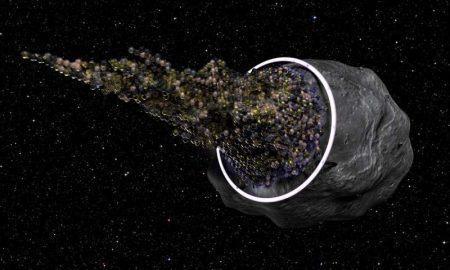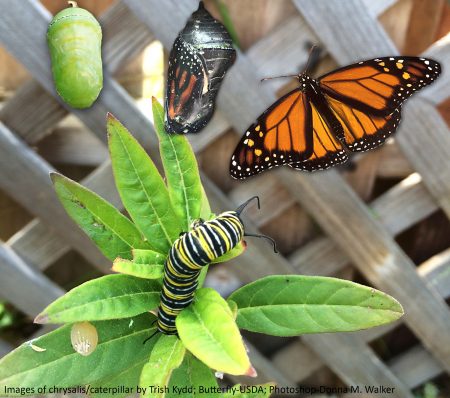September 17, 2018 – When I was a young man I was fascinated by the lifecycle of the Monarch Butterfly. On more than one occasion I brought home a fully grown caterpillar ready to turn into a chrysalis. I would carefully take the caterpillar and the plant upon which it was feeding and place them in a large jar where I could watch metamorphosis occur. It was a matter of hours or a couple of days before my caterpillar attached itself to a horizontal branch of the plant and began shedding his skin to reveal the emerald green casing that was to be the insects home for several weeks before emerging in all its butterfly glory.
The story of the Monarch came back to me this week when I read about students and researchers at Delft University of Technology, in The Netherlands, working on the design of a starship, an interstellar spacecraft designed to ferry humans from our Solar System to some distant one in the Milky Way. With the help of the European Space Agency (ESA), DSTART, the Delft Starship Team, came up with a cocoon-like design using a hollowed-out asteroid as the equivalent of our Monarch chrysalis to protect a multi-generational human crew crossing interstellar space to emerge on the surface of an alien planet circling a neighbouring benevolent star.
Identifying a Nearby Second Earth
It may seem far-fetched but before the end of this century, humanity could take what seems to be an impossible leap, an outward bound journey to Proxima Centauri where one of its planets could become home to our species. The planet in question is Proxima b. It is a Super Earth, 1.3 times the size of our planet. And although its orbit is 1/20th that of the Earth-to-Sun distance, because it circles a weaker red dwarf star, the amount of solar energy falling on its surface is roughly 2/3s that of Earth which still qualifies it to be in what exoplanet searchers call the Goldilocks Zone, where water exists on the surface and atmosphere in all three states. It is a given that we will need to know a lot more about Proxima b before ever considering sending a spaceship to it with a human crew aboard. Future space and ground-based telescopes should tell us if Proxima b is protected like Earth with its own magnetic field. That would certainly make it even more attractive exoplanet destination.
Going Interstellar Requirements
Before making the decision to go interstellar we have a lot of technology and science to address including:
- Completing our understanding of how our species could adapt physiologically and psychologically to what could be decade-to-century-long space travel.
- Building a spaceship with an onboard, balanced closed-cycle regenerative ecosystem that could sustain long-duration spaceflight.
- Developing new propulsion technology to be able to achieve speeds approaching at least 10% the speed of light.
Proxima Centauri is 4.22 light years from our Solar System. That’s 40 trillion kilometers (25 trillion miles) away. The fastest moving satellite to date, the Juno probe circling Jupiter, achieves speeds of 265,000 kilometers (165,000 miles) per hour. Traveling at that speed would require a journey of 17,157 Earth years. A proposal to send a group of nanosatellites to Proxima Centauri pushed by an Earth-based laser beam could achieve speeds of 215,850,000 kilometers (134,120,000 miles) per hour which would get us to Proxima b in a little over two decades.
At 10% of light speed, a spaceship with humans aboard would need at least a century to achieve the same. Why not just twice the time? Because the nanosatellites proposal is a one way fly by with no deceleration requirement. A spaceship with a human crew onboard would need to begin slowing down well before reaching the planetary system and then would have to navigate Proxima Centauri’s solar system before inserting itself into an orbit around Proxima b. The timing of that deceleration would be an interesting challenge for those who study orbital mechanics and space navigation.
Where the Monarch Butterfly Comes In
One way for us to achieve interstellar flights of such duration is to mimic the Monarch Butterfly. Our species could be genetically re-engineered to achieve the travel in both time and distance, including resource requirements to keep us alive, by entering a stage of stasis. We don’t have to be a caterpillar to emerge as a butterfly. But cocooning or a chrysalis stage could keep us living without consuming significant resources.
How the Monarch does it is remarkable. The caterpillar in the chrysalis literally liquefies and reorganizes genetically to emerge in all its butterfly splendour. With our increasing understanding of the human genome and with tools like CRISPR, we too may one day achieve a semblance of what the Monarch accomplishes, using it to populate planets circling many distant stars. Imagine reprogramming our human DNA to make it possible to live on Mars, or Saturn’s moon, Titan, or on Goldilocks Zone planets not quite as perfect as our own. The human crew that starts the journey can undergo profound change and emerge at the end a very different and adaptable creature.
States Angelo Vermeulen, a doctoral candidate at Delft University, and founder of the DSTART project team, “In light of our insatiable appetite for exploration, it is inevitable that the human species will ultimately travel outside of the known solar system. It is the next step in human evolution.” I’m not sure in saying these words he conceived that evolution could lead to a spacefaring species with the capability to do what the Monarch butterfly does. Where DSTART has been looking at the hardware and environmental engineering requirements, others can look at genetic modification.
The Interstellar Spaceship Concept
The DSTART project involves capturing and re-engineering a large asteroid. Excavation of the interior would create a miniature world for human occupants. Excavated material would serve two purposes: to be the ink for 3-D printing the interior, and as well, to serve as propellant.
For ecosystem support, the DSTART spaceship would need a closed-cycle system. The ESA eleven-nation MELiSSA program serves as a potential model. It currently is running a demonstration laboratory at the University of Barcelona where an air-tight multiple compartment “spaceship” with a crew complement of rats has been living sustainably for months at a time. The closed-cycle system is powered by a bioreactor that sustains oxygen-and-light-producing algae which in turn is fed by the carbon dioxide exhalations of the rat crew.
I know all of this sounds like fantasy. But the rudimentary technology already exists to turn it into reality before the century ends.

















